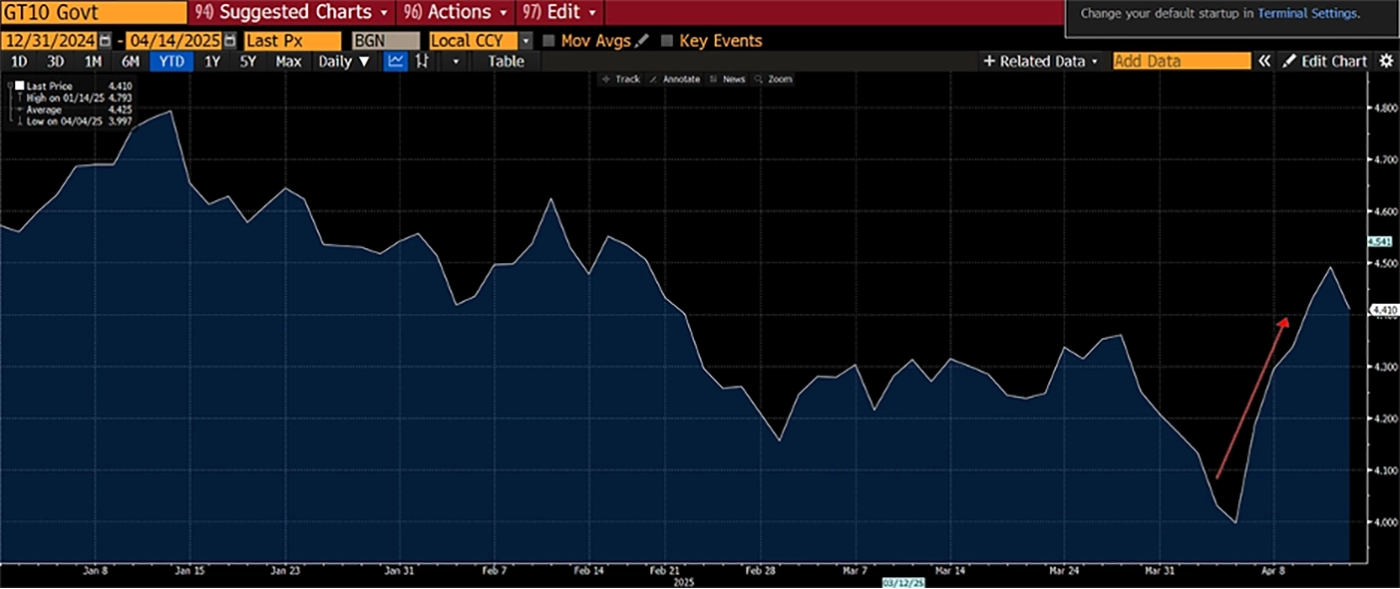Recent market activity, including tariff adjustments and significant moves in US Treasury yields, presents some noteworthy observations. From a 90-day pause on the “reciprocal” tariffs on most of our trading partners (the 10% remains), to an escalation with China (145% all in on Chinese made imports – China retaliated with its own 125% tariffs on US goods), to ultimately an exemption (details yet to be clarified) on goods such as cell-phones, computers, and other consumer/office electronics.
Instead of rehashing well-publicized events, let’s examine a few specific areas that may offer a more insightful perspective, starting with the dynamics within the US Treasury market.
1. US Treasury Market
We have often mentioned the diversification potential of high-quality bonds – especially US Treasury notes/bonds to downside equity market risk. Indeed, the “flight to quality” effects of US Treasury notes and the US Dollar drive significant allocations to these instruments in institutional asset allocation models. While one week is hardly significant to draw tangible conclusions, the rise in US Treasury yields during last week’s equity market turmoil surprised many institutional and retail investors. In our view, there were many factors at play.
Rising 10 Year Yield

First, Technical Factors – Some highly leveraged structures were unwound last week causing selling pressure on US treasury notes. Leveraged investors borrow short term money to amplify their long positions (think leveraged ETFs, Hedge Funds) and post US Treasury notes as collateral for their loans. As market values in various markets (stocks, commodities) fell last week, positions were unwound causing US Treasuries to be liquidated as managers de-levered.
Next, Bond Futures – This is technical, but bear with me as I break it down. A lot of very large, fixed income investors (Reserve banks, sovereign wealth funds, insurance companies) obtain exposure to US Treasuries through the T-Note (10 year) and T-Bond (30 year) futures market. Both 10-year and 30-year Treasury futures contracts are based on notional/rather than real instruments and have several deliverable Treasury bonds and notes against them, resulting in a cheapest to deliver option for the seller of the futures contract. The cheapest to deliver note/bond is the one in which the seller of the futures contract can earn the most interest up to the actual futures delivery day. At various points last week, this basis (interest earning potential) turned tight enough for sellers to close out their futures positions and then sell the deliverable notes and bonds.
2. Impact of US Tariff Policy on International Markets
Technical sell offs are usually short-term as leverage limits are curtailed, and risk is taken off by leveraged investors. However, the rise in bond yields had been accompanied by a weakening of the US Dollar -8% vs. the Swiss Franc (CHF), -5% vs. the Euro (EUR), -5.3% vs. the Yen (JPY). This suggests that capital is flowing out of the USA and foreign central banks are curtailing their positions in US Treasuries. We cannot predict how long this will last, but clearly, the tariffs are causing a rollback in globalization.
3. US Federal Reserve
In last week’s tariff update, we mentioned that the last time tariffs of the current magnitude were implemented – the Smoot Hawley tariffs of 1930. During that time, the global economy went into a tailspin, and the world experienced the Great Depression. However, we believe deflation/depression is unlikely this time as the Federal Reserve Bank is likely to pursue a more accommodative monetary policy should the US enter into a recession. One of the policy mistakes in the 1930s was that the Federal Reserve maintained a tight monetary policy to preserve the value of the US Dollar, which at the time was tied to Gold. We cannot see that happen again. Conversely, a looser monetary policy in response to falling growth may result into a bout of Stagflation – where low growth is accompanied by higher inflation and persistently higher bond yields.
Conclusion
In essence, the recent market fluctuations, particularly the unexpected rise in US Treasury yields, were influenced by a combination of technical factors and institutional responses. Understanding these underlying dynamics, including the role of market values as collateral, is crucial for navigating the current economic environment.


